Quilt Gallery
Celebrate Life
Art is an excellent way to express emotions. For this exhibit, artists depict how they, a family member, or a friend celebrated a loved one’s wedding, birth, birthday, or memorial. Colors, patterns, traditional blocks, or abstract drawings can be combined or used alone to convey a range of emotions from happy to sad.
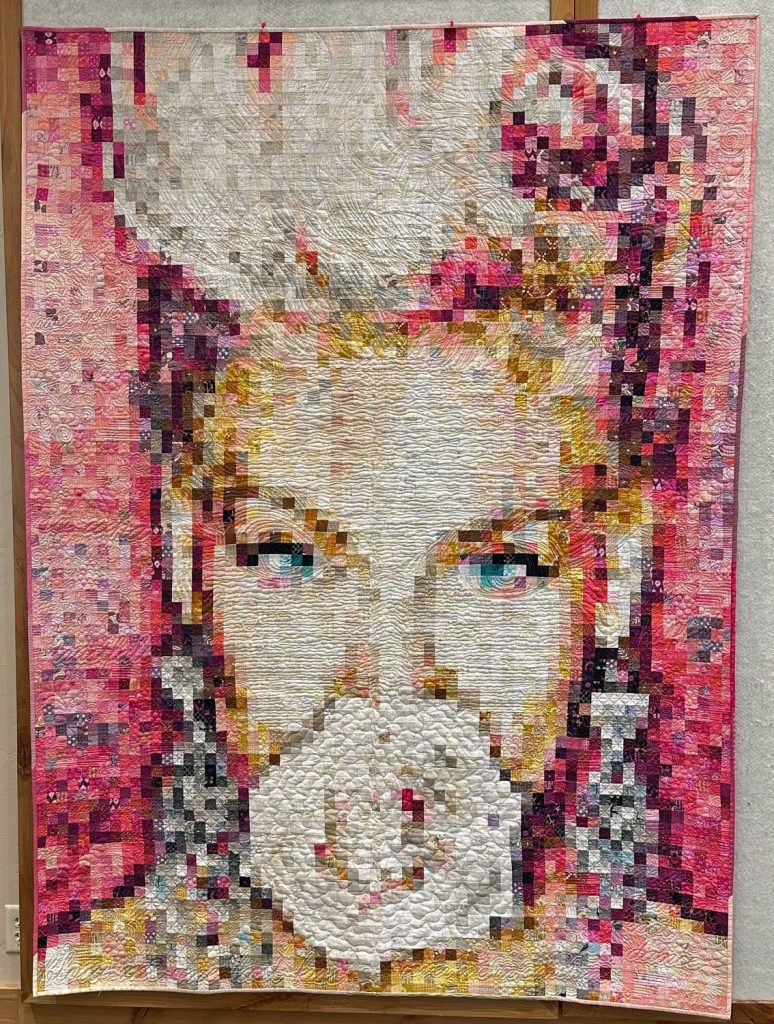
Alecia Beth
by Shelly Shoultes Quilted by Natalia Bonner
Washington, UT
USA
Techniques: Machine pieced and quilted; original digitized quilting
Design Source: P!nk Truth About Love Tour; adapted from t-shirt image and various images on social media
This was inspired by the singer/songwriter P!nk, a.k.a. Alecia Beth Moore. Her music, lyrics, style, and unfiltered thoughts celebrate life and authenticity to oneself. This quilt is a tribute to her as an amazing artist and to women everywhere! It represents friendship, strength, compassion, and nurturing. “True beauty is knowing who you are and what you want and never apologizing for it.”— P!nk
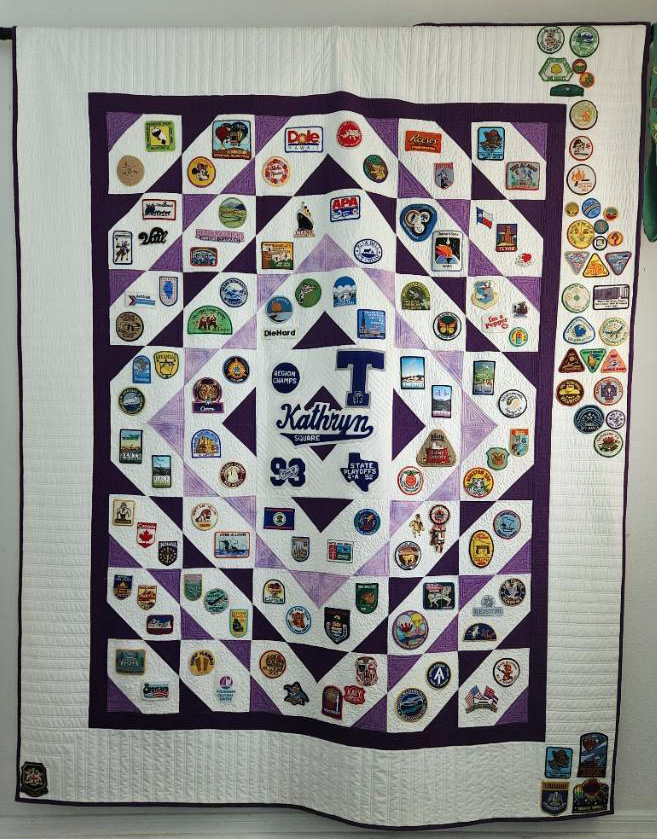
An Americana Celebration
by Diann House Quilted by Peg Collins
Houston, TX
USA
Techniques: Hand appliquéd; machine appliquéd, pieced, and quilted
Design Source: Pinterest and Moda Fabrics; variation of Quarter Square Triangles and squares
My daughter collected patches from places we visited, clubs she belonged to, and any that she just thought interesting. After sewing them on numerous jackets, which she promptly outgrew, I settled on a quilt that I gave her for her college graduation. She still collects, hence the additional patches on the border of the quilt.
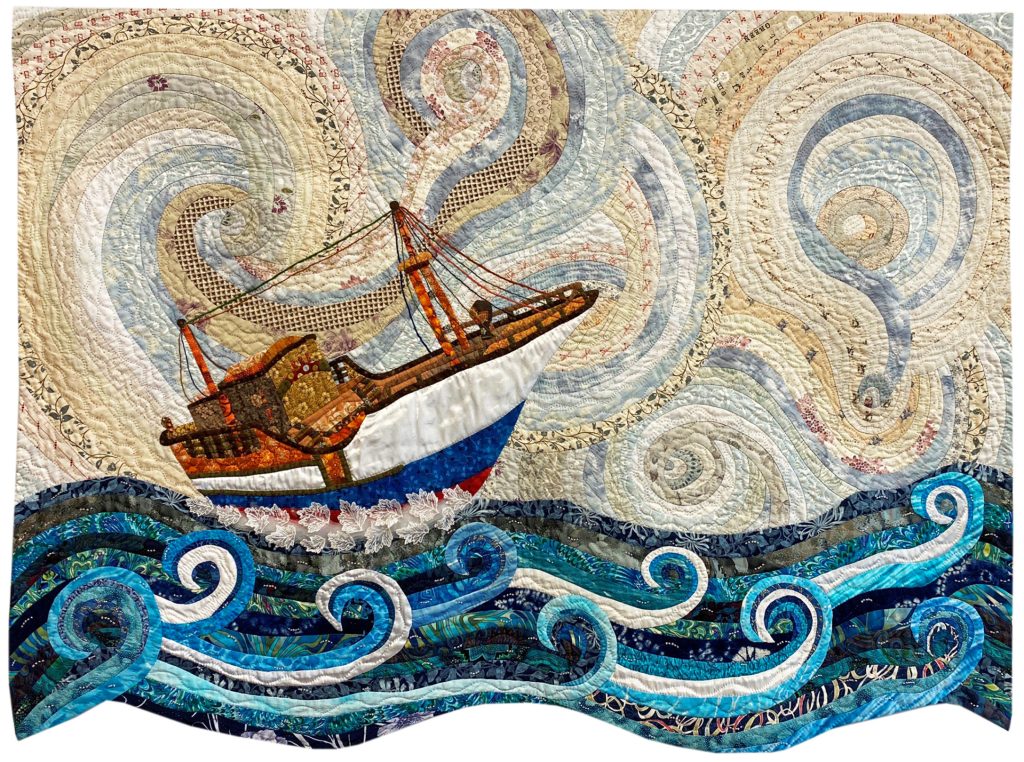
Brave the Winds and Waves
by Yen-Chiu Chen
Tainan City
TAIWAN
Techniques: Hand-appliquéd, embroidered, pieced, and quilted
Design Source: Original design
My father passed away last year. He was a captain who sailed against the wind and water. He fought with the sea and protected our family with his whole life. This quilt is a blessing for the family. He sailed off happily, braving the wind and waves, stayed safe, and returned with fruitful results.
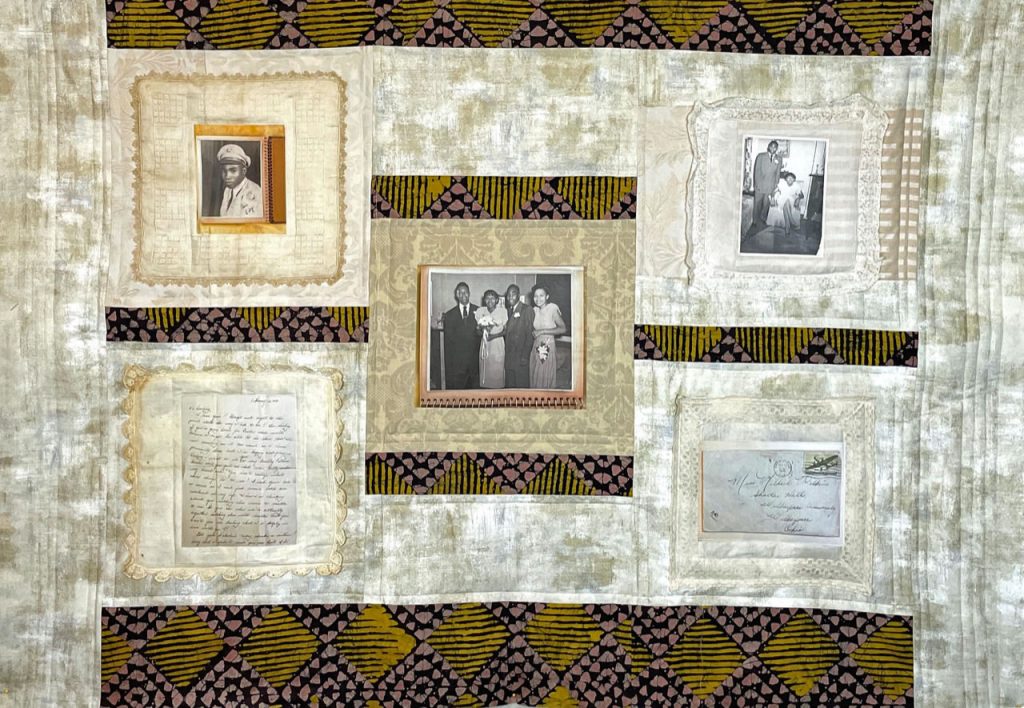
Calvyn & Millie Baltimore Wedding Album
by Carole Lyles Shaw
Bradenton, FL
USA
Techniques: Machine pieced and quilted; photo transfer
Design Source: Original design
This is a celebration quilt commemorating my parents' wedding, attended by friends and family in my grandparent’s home in Baltimore, MD. It also includes a letter written to my mother by my father while he served in the US Army.
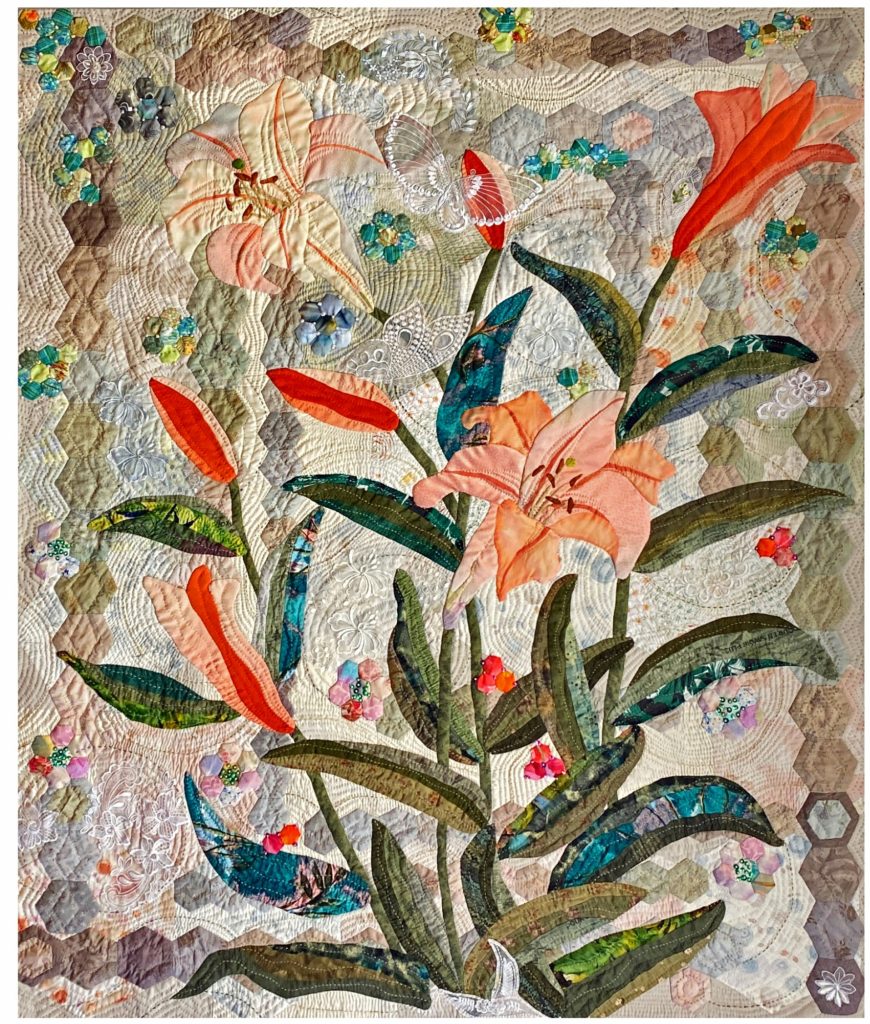
Grandmother’s Flower Garden
by Hsin-Chen Lin
Tainan City,
TAIWAN
Techniques: Hand appliquéd, embroidered, pieced, and quilted
Design Source: Original design
My mother passed away just a few days before Mother’s Day. I sorted out fabric scraps beside her sewing machine and used the materials that she had accumulated over the years to create this work in memory of her. It was only during the sewing that I realized how a woman cultivates herself continuously from a young to an elderly age in her lifetime. This is the last lesson she taught me.
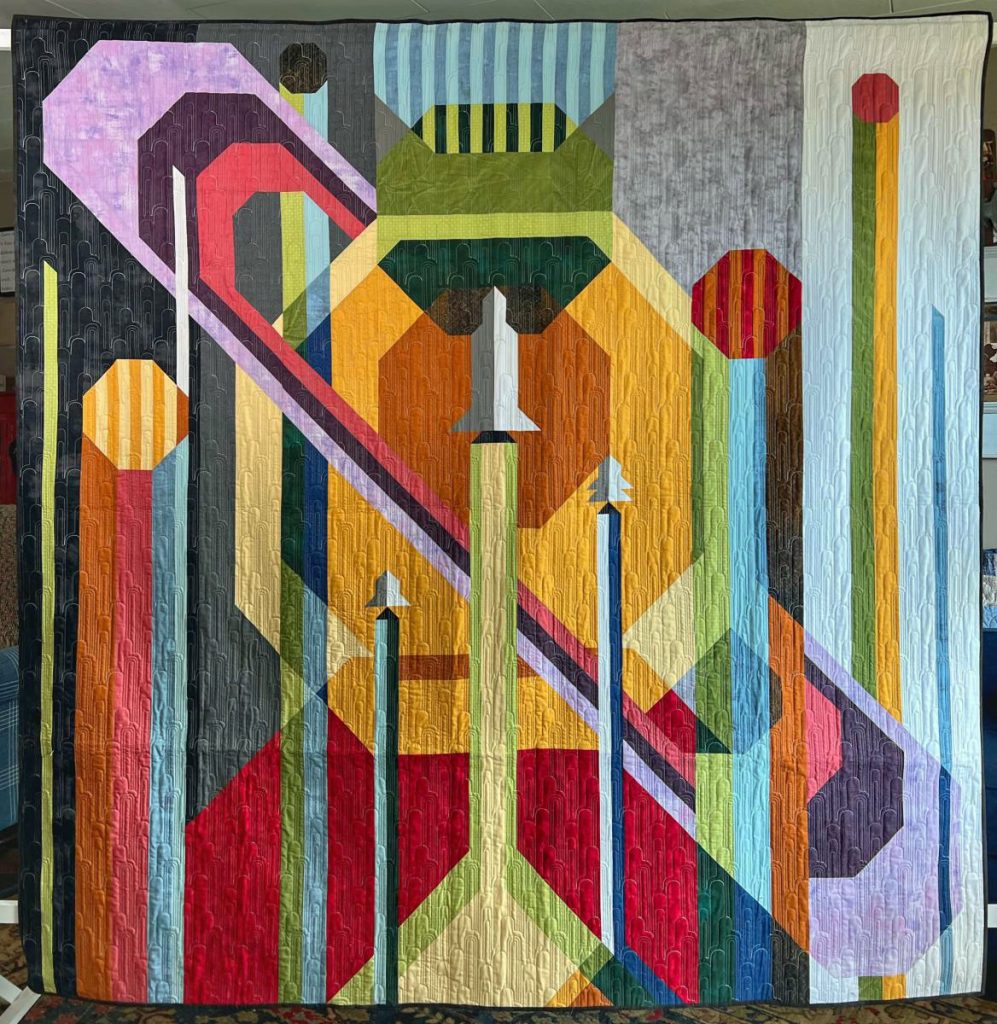
Harland’s Space Quilt
by Pam Plotner
Washougal, WA
USA
Techniques: Hand-pieced; machine quilted; commercial digitized quilting design
Design Source: Space Travel Quilt pattern by Rye Bread Quilt Co.; E2E pattern—Deco Arch by Longarm League
My son-in-law asked if I would make this pattern for my grandson Harland’s 3rd birthday. Panda had to say yes! He opened the gift at his party. I took it back and entered it in our local quilt show the next weekend. It won the NACQJ Award, 2nd place, and Best Non-Traditional. This quilt has been in three other shows and won a ribbon at each of them. He just turned five, and he may never get this quilt back!
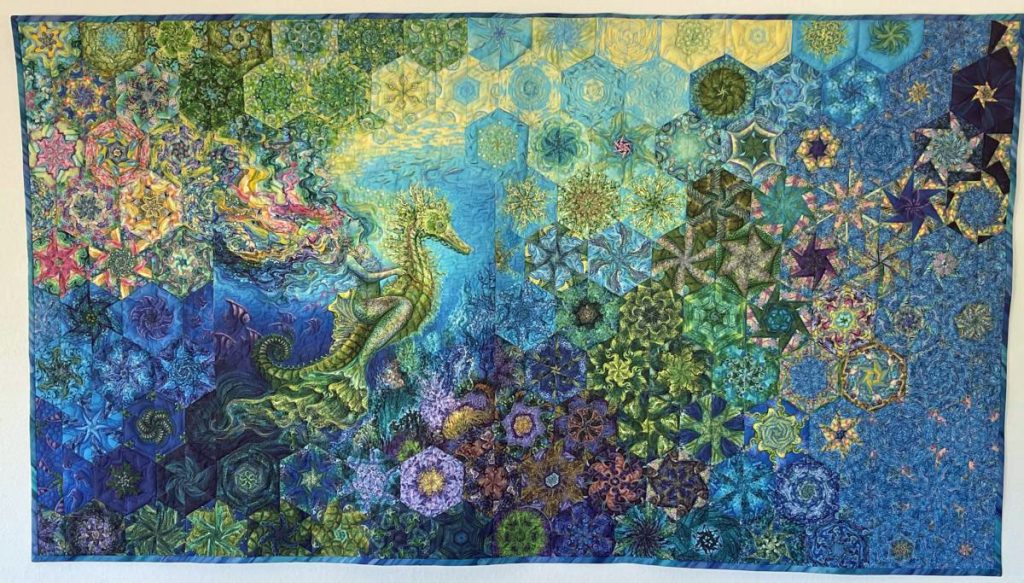
Harmony Pacifique
by Marie Dufour
The Villages, FL
USA
Techniques: Machine pieced and quilted; original digitized quilting
Design Source: Original design
This celebrates eleven years of cruising and snorkeling the world’s oceans with my husband. I suffered a stroke, putting an end to our cruising days. My husband called for a quilt to memorialize the life of his favorite mermaid riding the most elusive creature, the seahorse, amid a pristine coral reef garden.
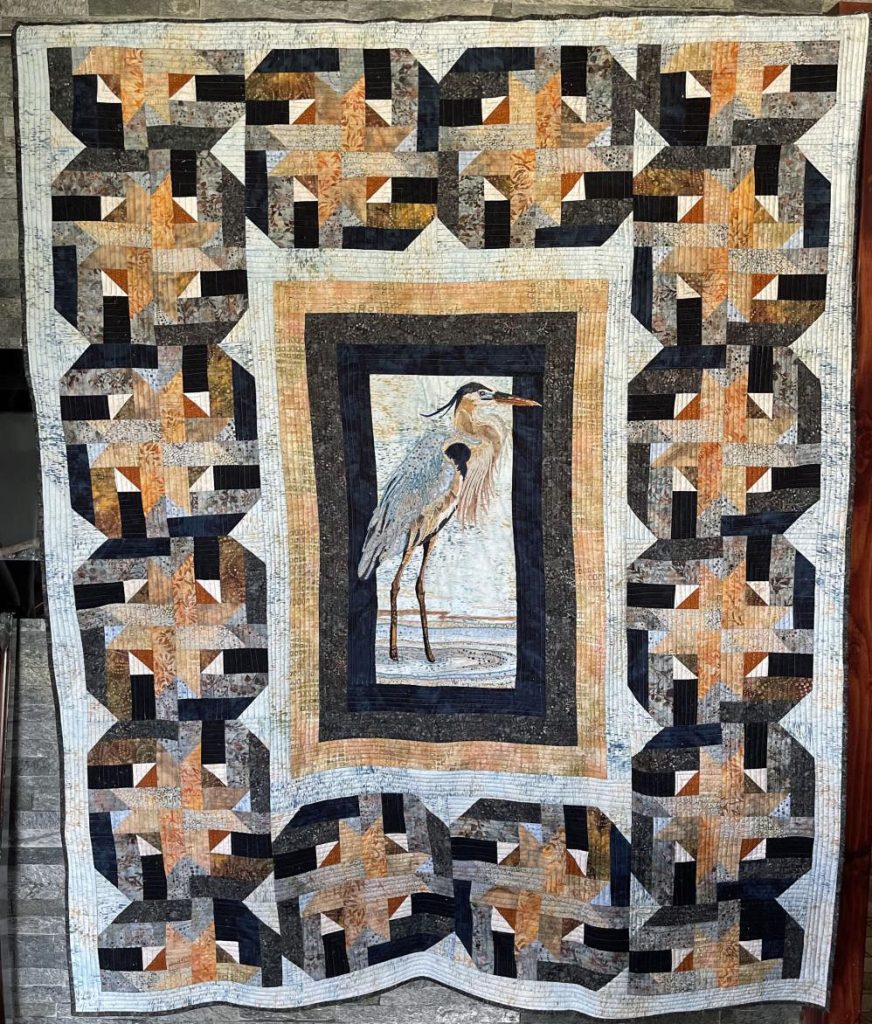
Heron on My Heart Artur
by Theresa Musakhanyan
Akron, OH
USA
Techniques: Machine embellished, pieced, and quilted
Design Source: The Great Blue Heron pattern, Toni Whitney; Regent Street pattern from Tabletastic! 2 by Doug Leko, Antler Quilt Designs
I made this quilt in honor of my husband, Artur. He is like the mighty Great Blue Heron. He is majestic, tranquil, and has a calming effect during the storms of life, much like the feel of this quilt.
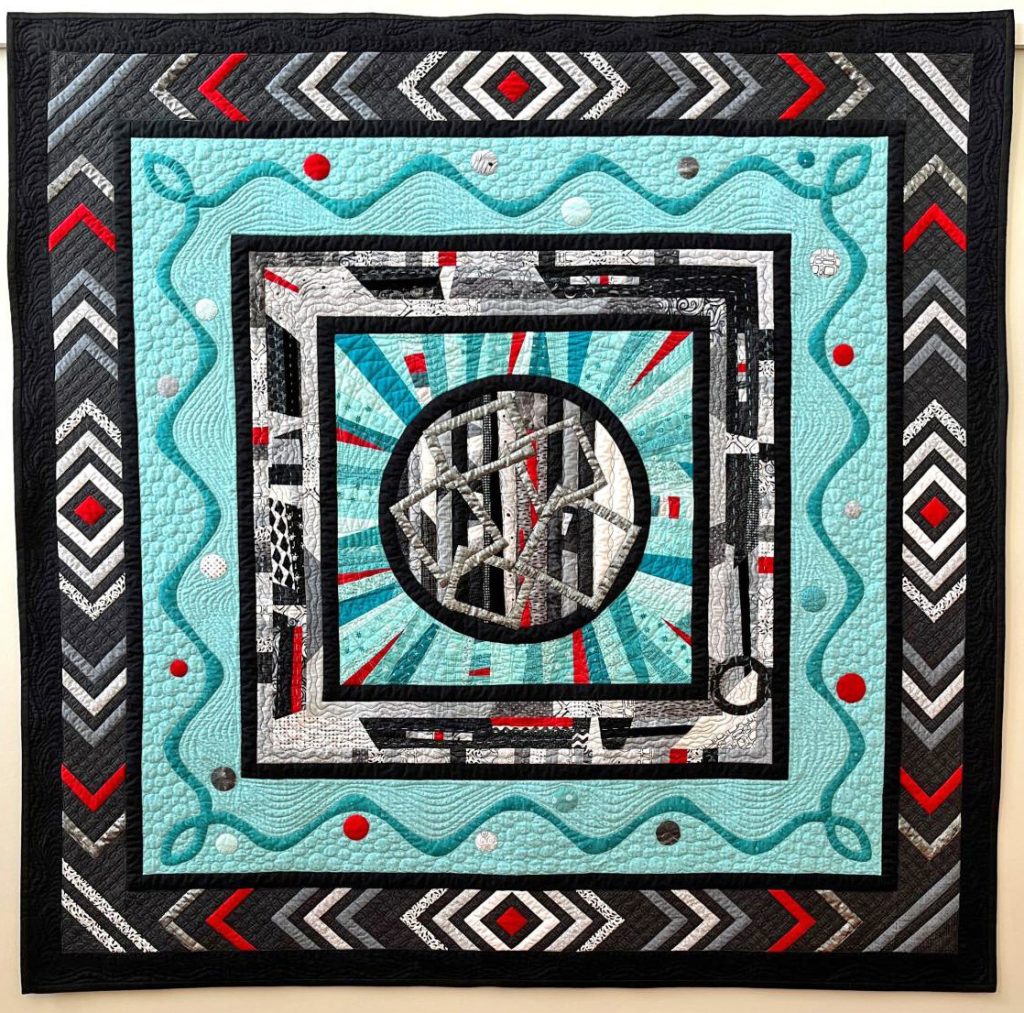
I Had a Good Life
by Tannis Fahlman
Regina, SK
CANADA
Techniques: Machine appliquéd, pieced, and quilted
Design Source: Original design
This quilt is a tribute to my dad. The nucleus is his family and the next section depicts his busy life as a farmer. Retirement depicts grandkids, golfing, and cottage life. Near the end, Dad’s words to me echo, “I had a good life; I had a very good life.”
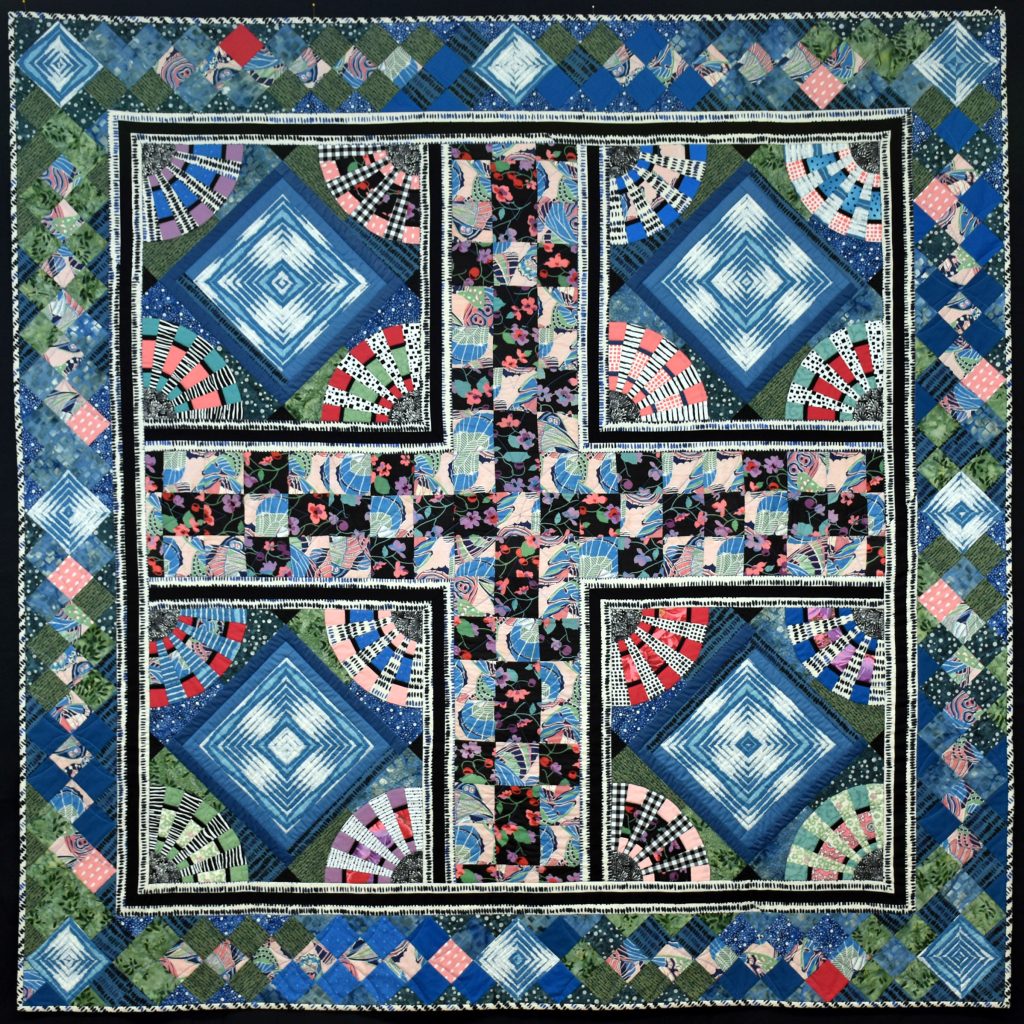
Ida’s Blocks Series—#4
by Karen Hansen
Overland Park, KS
USA
Techniques: Machine pieced and quilted
Design Source: Original arrangement of vintage blocks
Ida died in 1950. In poor health and confined to a sanitarium, she made quilt blocks…hundreds of them...to pass the time! As a friend of the family, I inherited those blocks. This quilt is #4 in a series using Ida’s blocks…my way of keeping her memory alive.
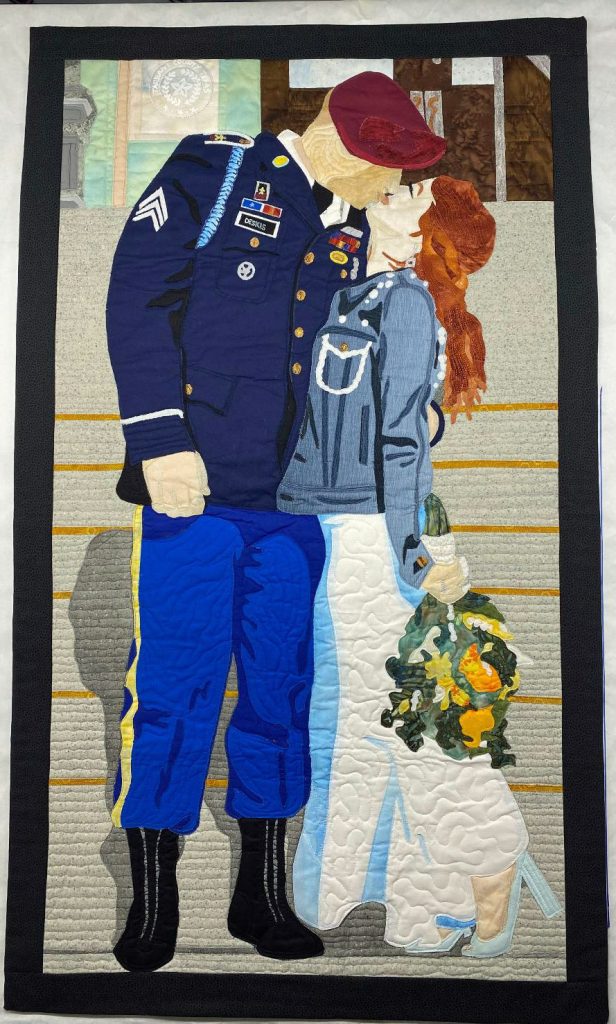
Love Is in the Air—Deskis 2-22-22
by Jane Deskis
Leavenworth, KS
USA
Techniques: Machine appliquéd and quilted; shaded with InkTense pencils; stenciled with a fabric pen
Design Source: Original design using the photo from the wedding kiss on the steps of the courthouse
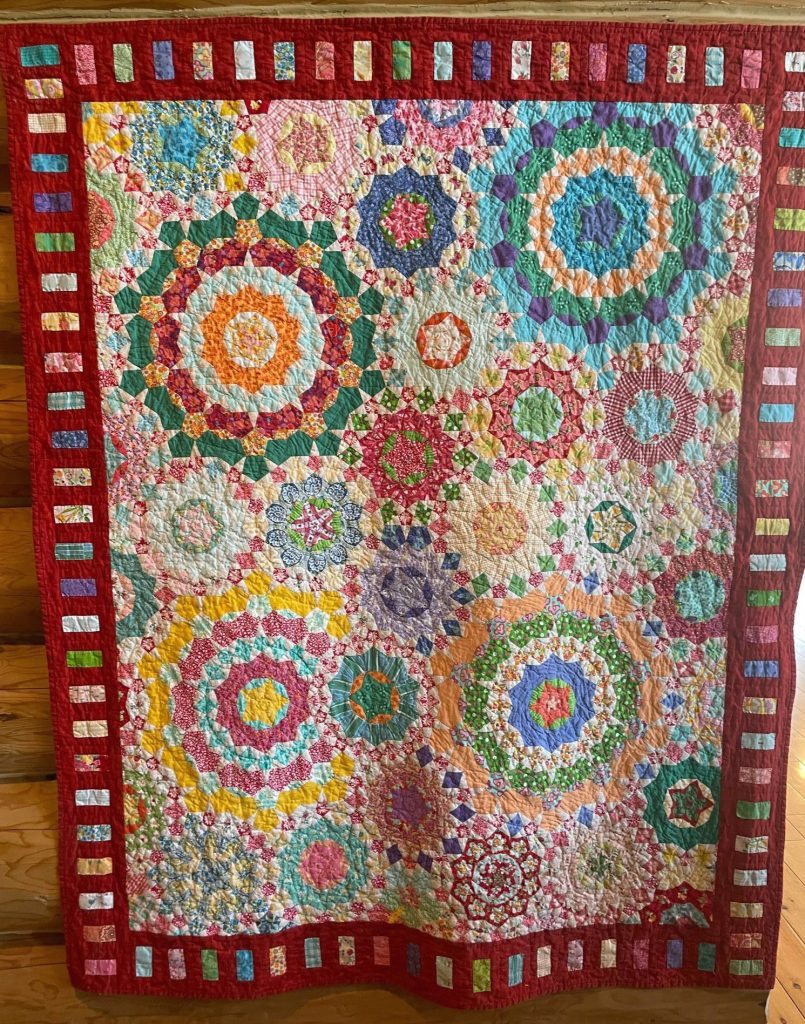
Mama’s Garden
by Judi Alexander
Great Falls, VA
USA
Techniques: Hand-appliquéd, pieced, and quilted; English paper piecing; machine quilted
Design Source: La Passacaglia pattern from Millefiori Quilts 1 by Willyne Hammerstein
This quilt was made to celebrate Mama’s eighty-ninth birthday. The rosettes represent her children, grandchildren, and great-grandchildren. Though bedridden when we started it, she enjoyed helping with fabric choices and various fussy-cut designs. The bright colors reflect her optimistic and happy view of life.
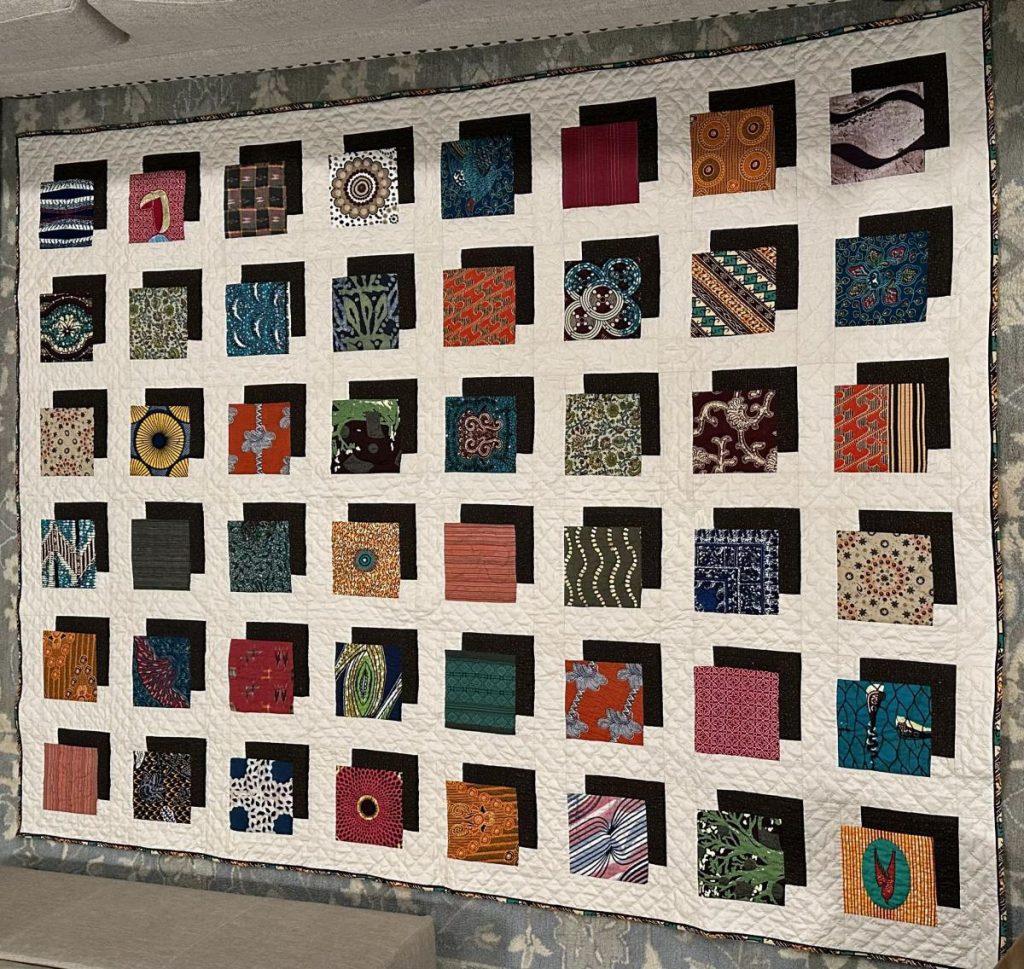
Melissa’s Mission
by Theresa Klein
Seabrook, TX
USA
Techniques: Machine pieced; hand quilted
Design Source: Shadow box; Pattern drafted to fit the scale of my fabric; Inspiration from photos of String blocks by Alwaysquilting.com and Four Square Float Quilt by Sarah Zimmerman for Quilting Daily
My sister, Melissa, spent four years overseas as a missionary liberating and rehabilitating victims of human trafficking. When she came home, she gave me fabric—the perfect gift! I love the exuberant colors and the challenges the fabric presented. It was used to make this quilt and another that I donated to Stitches of Love, a ministry of UBC. This quilt celebrates my sister, her mission, and using our God-given talents to love others.
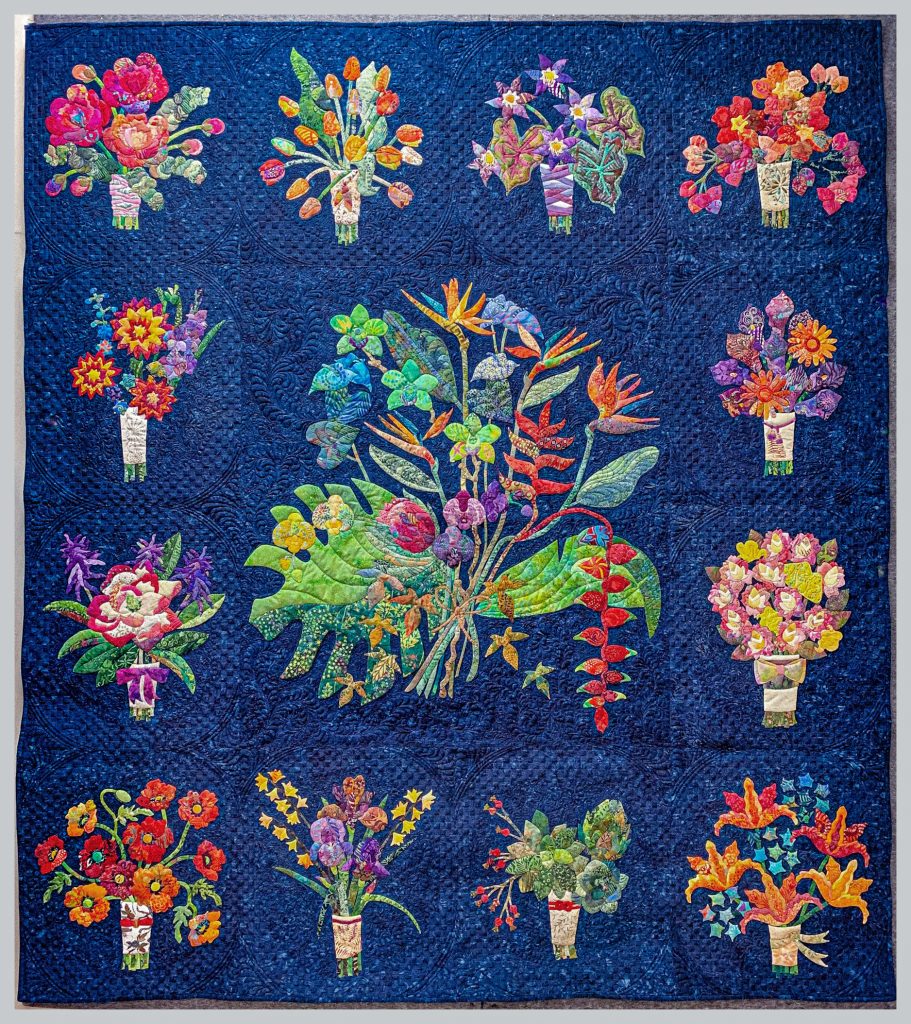
My Daughter’s Wedding
by Audrey Sussman Quilted by Angela McCorckle
Georgetown, TX
USA
Techniques: Hand-appliquéd; machine pieced and quilted
Design Source: The center block is an original design. The 12 surrounding blocks are based on the Eye Candy Quilts pattern, 16th and Baltimore.
This quilt commemorates my daughter’s wedding. Each block is a bridal bouquet. Jasmine wanted proteas in her bouquet. I grew up with Mom’s Bird of Paradise plant, and the center block blossomed accordingly. The quilt label is a boutonniere honoring my son-in-law.
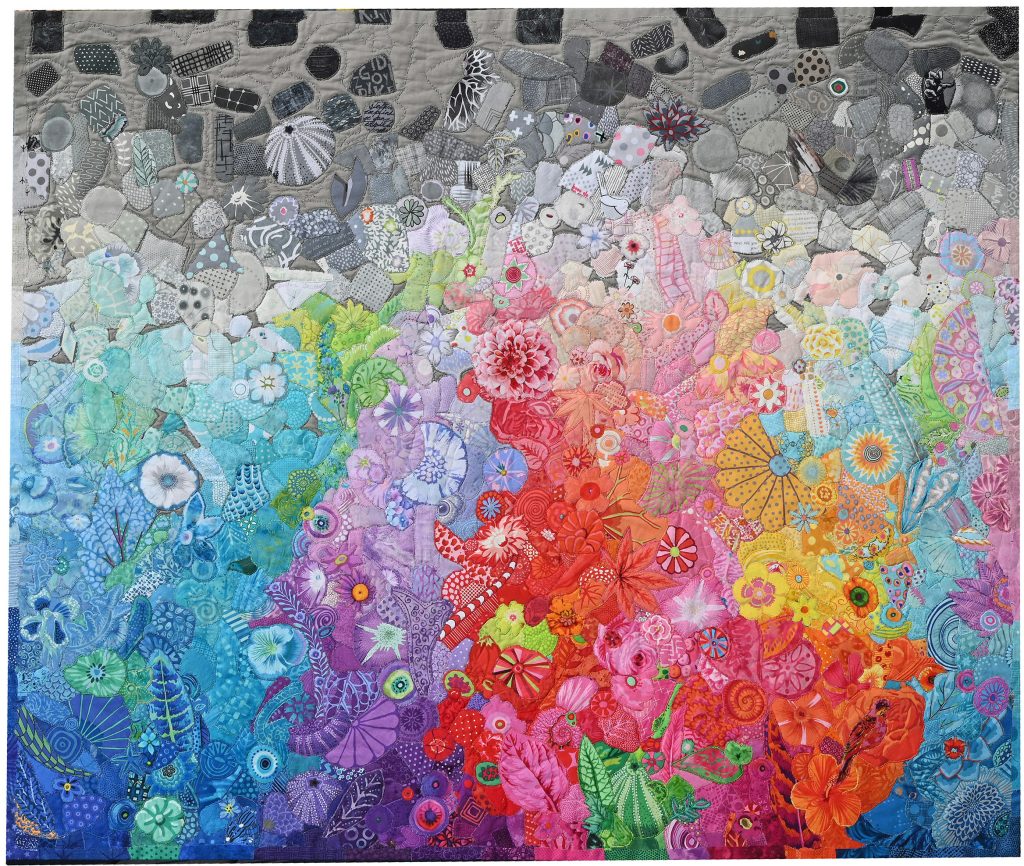
My Mother Has Alzheimer’s: These Last Five Years
by Carly Mul
Hamilton, VA
USA
Techniques: Hand-pieced; machine appliquéd and quilted; collage; raw-edge fusible; free-motion tiny zig-zag for organic quilting
Design Source: Original design
This was inspired by my mother who was a colorful, strong woman until Alzheimer’s started to show up. She slowly bleached out and entered a world of grey and darkness. She sometimes realizes this, and it makes her sad and mad. I hardly recognize this patient as my mother and almost want to defend the sick old woman by showing you how beautiful she was and always will be, too. Alzheimer’s cannot take that away.
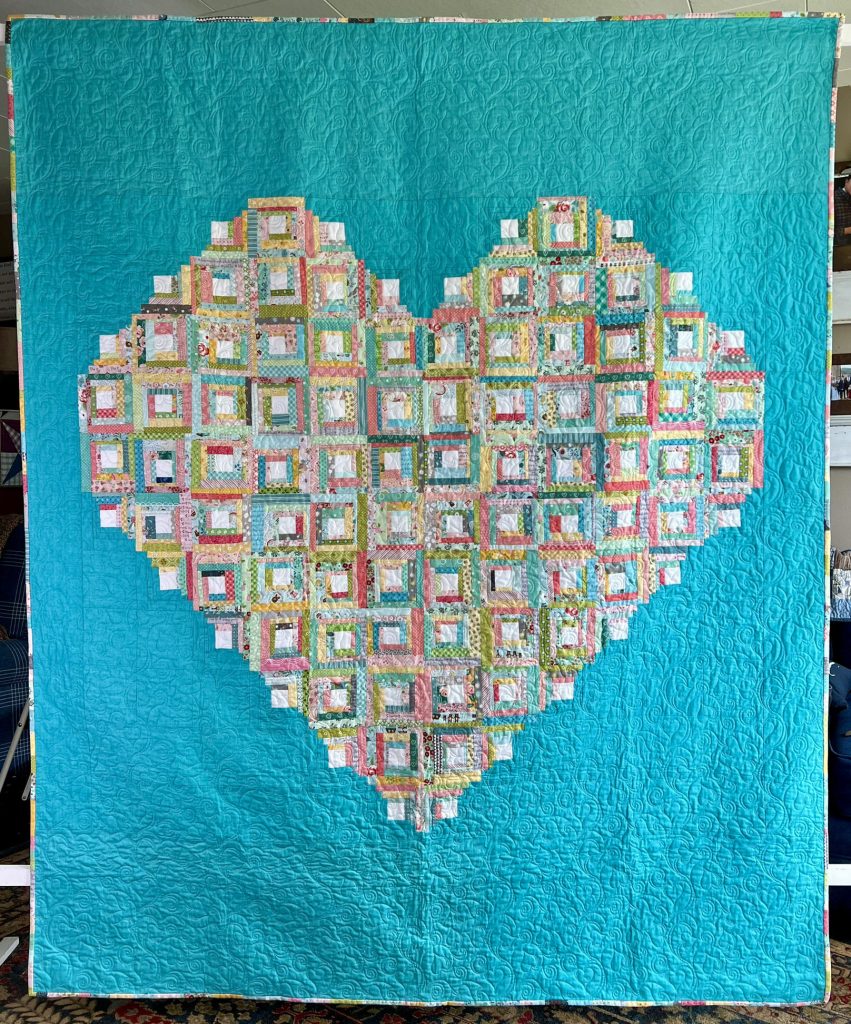
Nona’s Heart
by Pam Plotner
Washougal, WA
USA
Techniques: Machine pieced and quilted
Design Source: Original design
To relieve stress during my mom’s illness, I would come home after sitting bedside and sew leftover strips of fabric from my three granddaughters’ quilts around a white square. I created these wonky Log Cabins with nothing in mind. After Mom’s passing, I knew I needed to create this heart to symbolize what she meant to me and her grandgirls. She would have loved this quilt as much as she loved them!
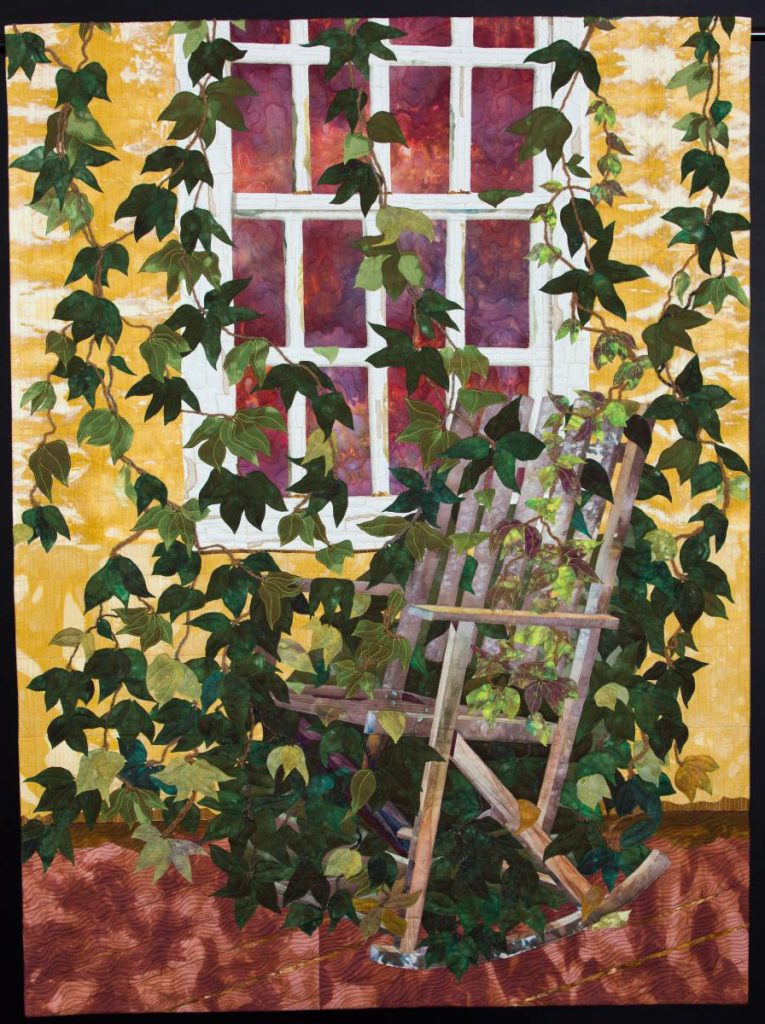
Off Her Rocker
by Sandra Holland
Cortland, NY
USA
Techniques: Hand-embellished and dyed; machine appliquéd, pieced, and quilted
Design Source: Original design
This quilt was inspired by a rocker on my sister Arlie’s backyard deck that became overgrown with ivy when advancing cancer made her too weak and disoriented to take her morning tea there. I found the parallel of being consumed disturbing until I realized that the symbolism might appeal to her.
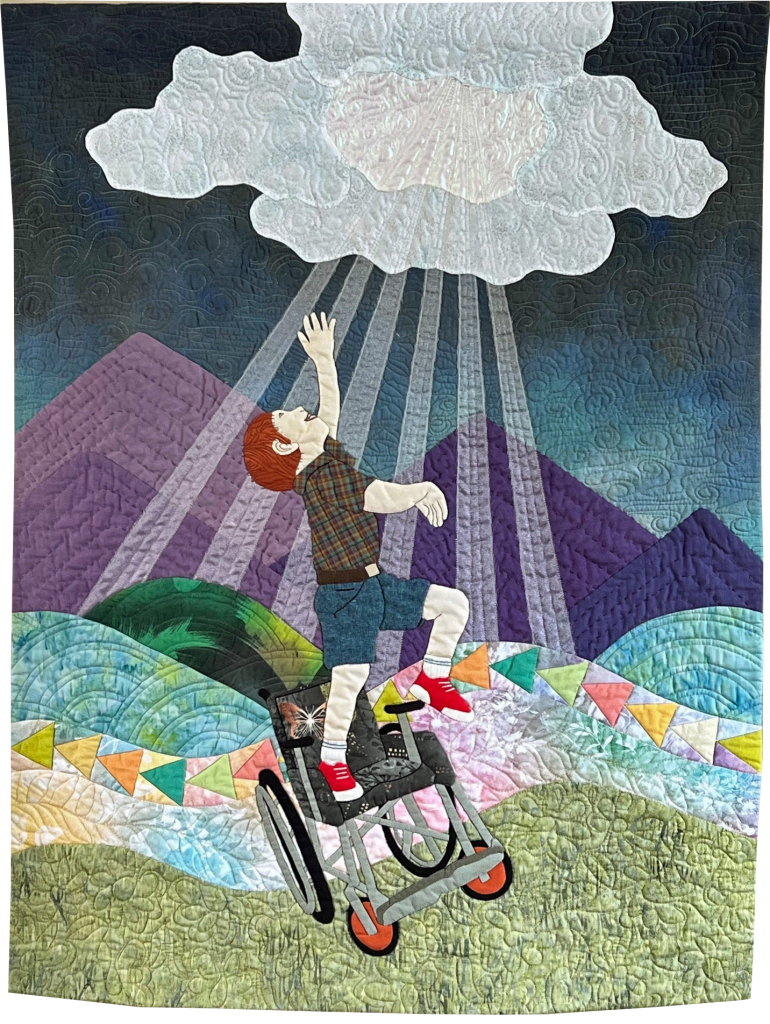
Returning Home
by Pam Hadfield
Laguna Niguel, CA USA Techniques: Hand-appliquéd; machine quilted Design Source: Original design; from a photograph I took at the Salt Lake City, Utah grave of this sweet boy; permission granted by his father Mathew Robinson was born deprived of oxygen, causing him to be severely handicapped. He was expected to live only a few hours but lived to be 10 years old. Confined to his wheelchair most of his life, his father designed and created this statue for his gravesite, depicting him leaving this earthly life and gaining freedom from affliction in the next life.
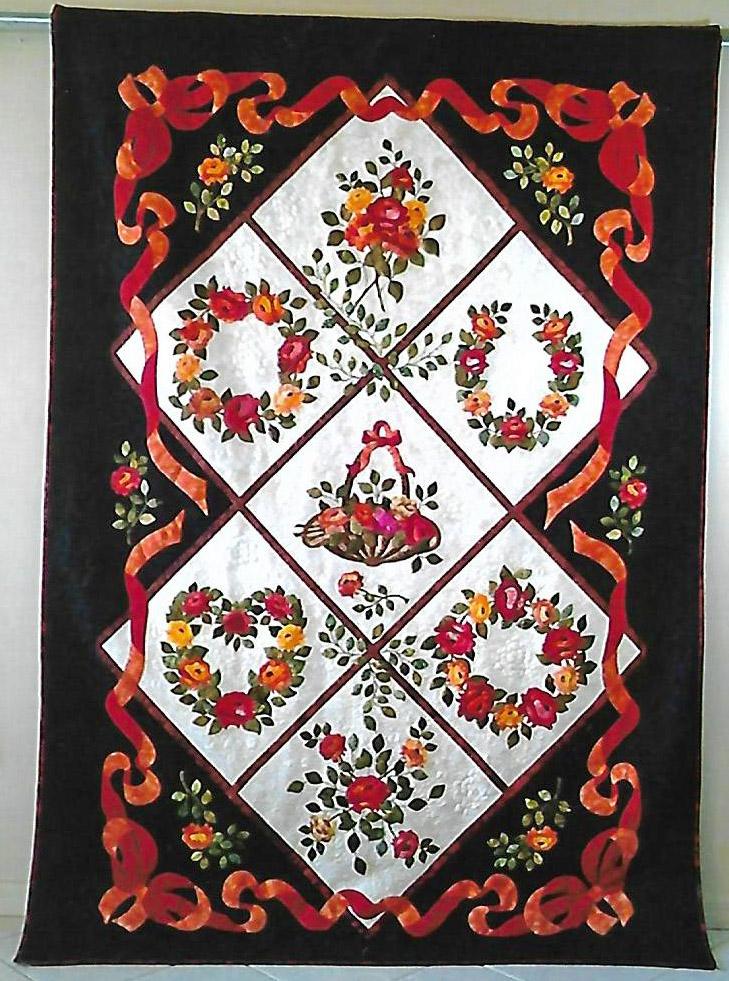
Roses for My Mother
by Rosillis L. Rosario
Las Vegas, NV
USA
Techniques: Hand-appliquéd and embellished; machine ribbon embellishment and quilting
Design Source: Patricia Cox
The care and love my mother gave her roses in southern California inspired me. They were big and beautiful!
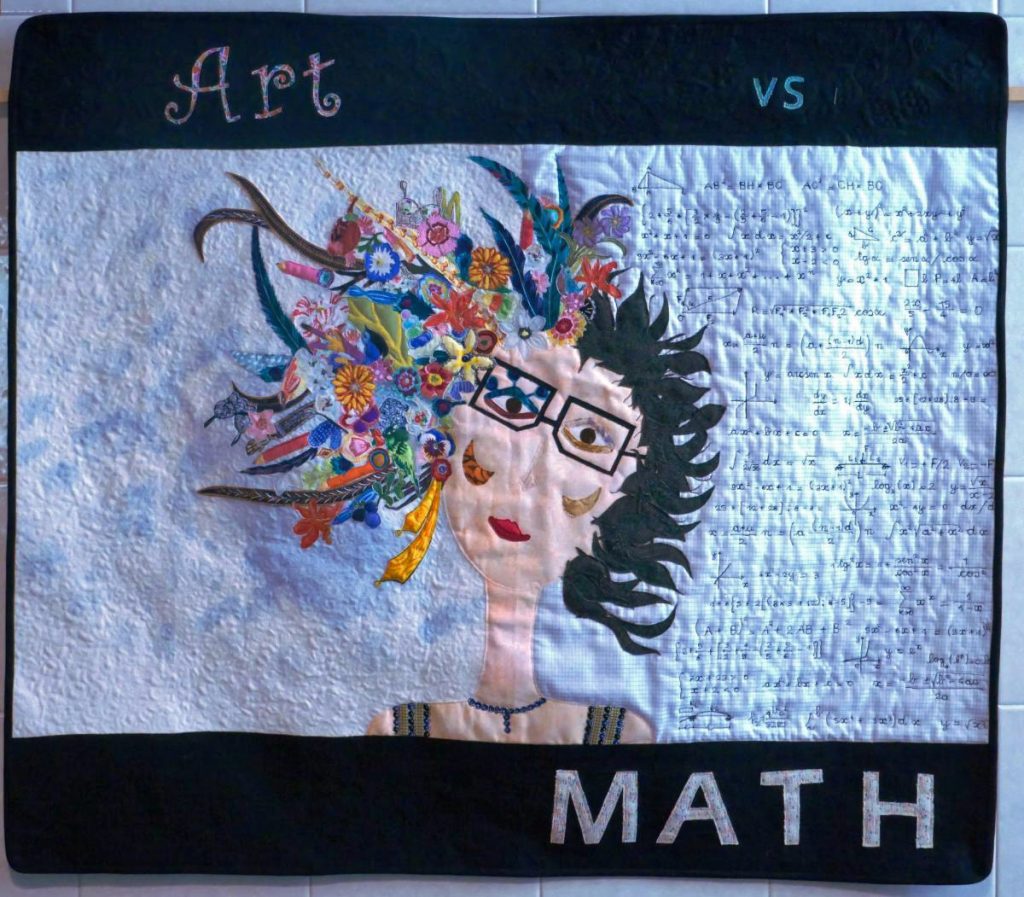
Self-Portrait
by Laura Gamaleri
Genova
ITALY
Techniques: Machine appliquéd and quilted
Design Source: Original design
One cherished memory of my childhood involves my Granny and me sewing doll garments. Through the storm we call life, I became an engineer and led a busy family life, but my love for fabrics and threads held firmly within me. My self-portrait celebrates the two sides of my personality that make me whole—the mathematical and logic-driven side and the artistic, colorful, and playful one.
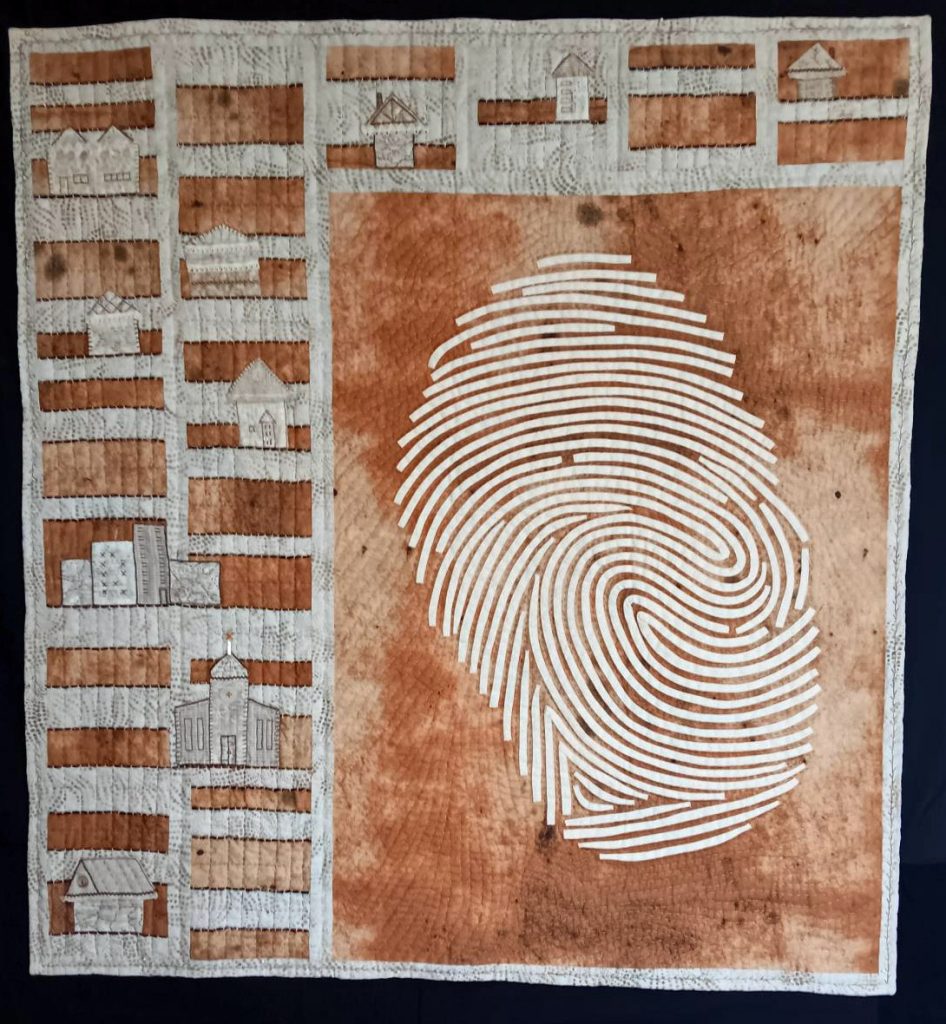
The Storm in Craig’s Fingerprint
by Gina Gililland McCasland
Lubbock, TX
USA
Techniques: Hand appliquéd, embellished, embroidered, and quilted; machine pieced
Design Source: Original design
The final moments before a hurricane makes landfall appear deceptively un-suicidal. Craig was killed by terminal depression and despair; even with the strong structures of family, home, work, and church, he collapsed under pressure. We did all we could to protect our son but were powerless against the storm’s onslaught.
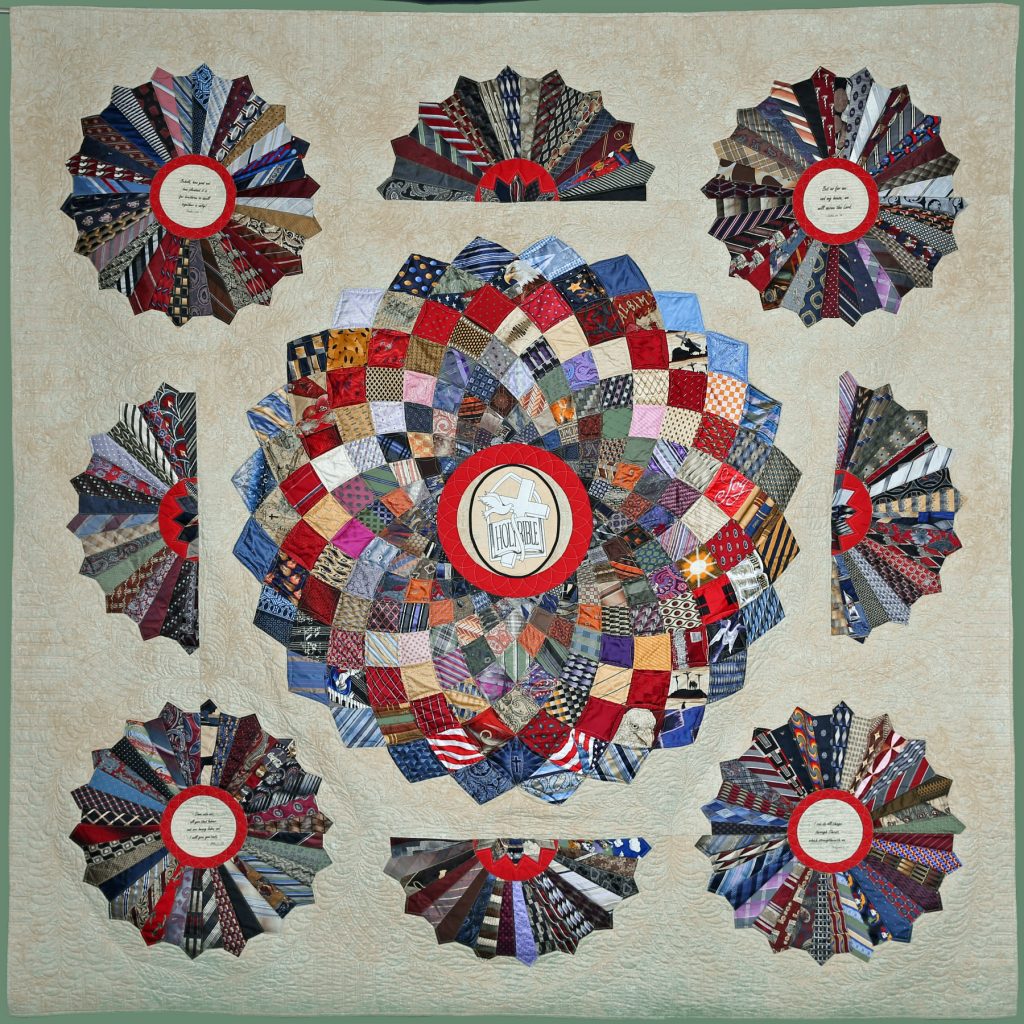
Ties That Bind
by Gail Smith Quilted by Ida Anderson
Magnolia, TX
USA
Techniques: Machine appliquéd, pieced, and quilted; printed words on printable fabric at home
Design Source: Center medallion pattern found on the internet with no name given; Dresden Plate variation on the corners and 1/2 Dresden Plate for the outer sections between the corners
The quilt is a celebration of 420 men. Many serve or have served as ministers, deacons, and members. Their birth years range from 1879 to 2001—four from the 1800s, 414 from the 1900s, and two from the 2000s. I have a new respect for the price of ties after taking them apart. The prep work took much longer than the sewing project. I pieced it from March to May and then gave it to the quilter, who breathed life into this unique project.
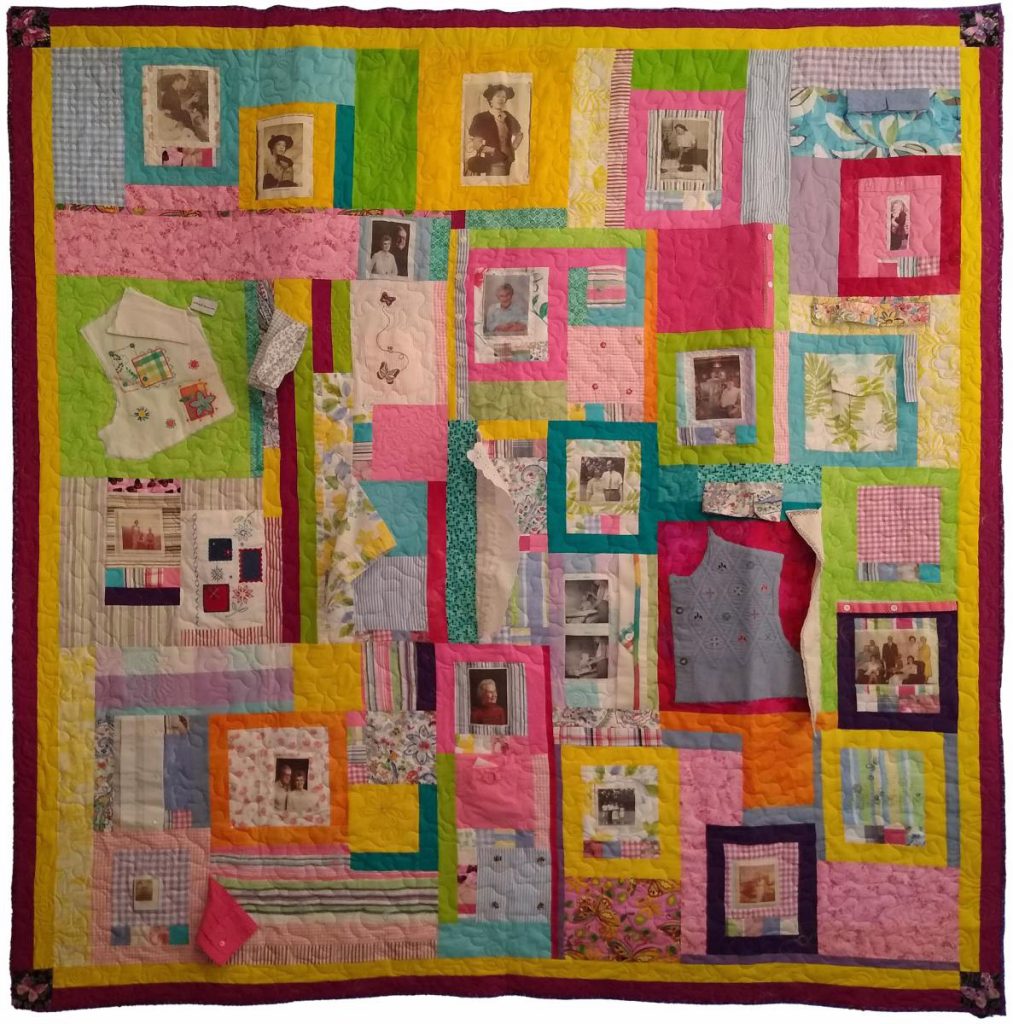
We Remember Mom
by Barbara Bowman
Clarksville, TN
USA
Techniques: Machine pieced and quilted; photo transfer; some fabrics (pieces of blouses) have commercial embroidery
Design Source: Original design using clothing belonging to my mother, who died in 2012
When my mother passed away in 2012, I gathered all her blouses from her closet. I decided to make a memory quilt for myself and quilts for my sister and brother. I cut pieces of the blouses and sewed them onto existing fabrics that I had on hand. I used photo transfer in the quilt and can remember when each photo was taken. This quilt brings back many happy memories made with Mom.
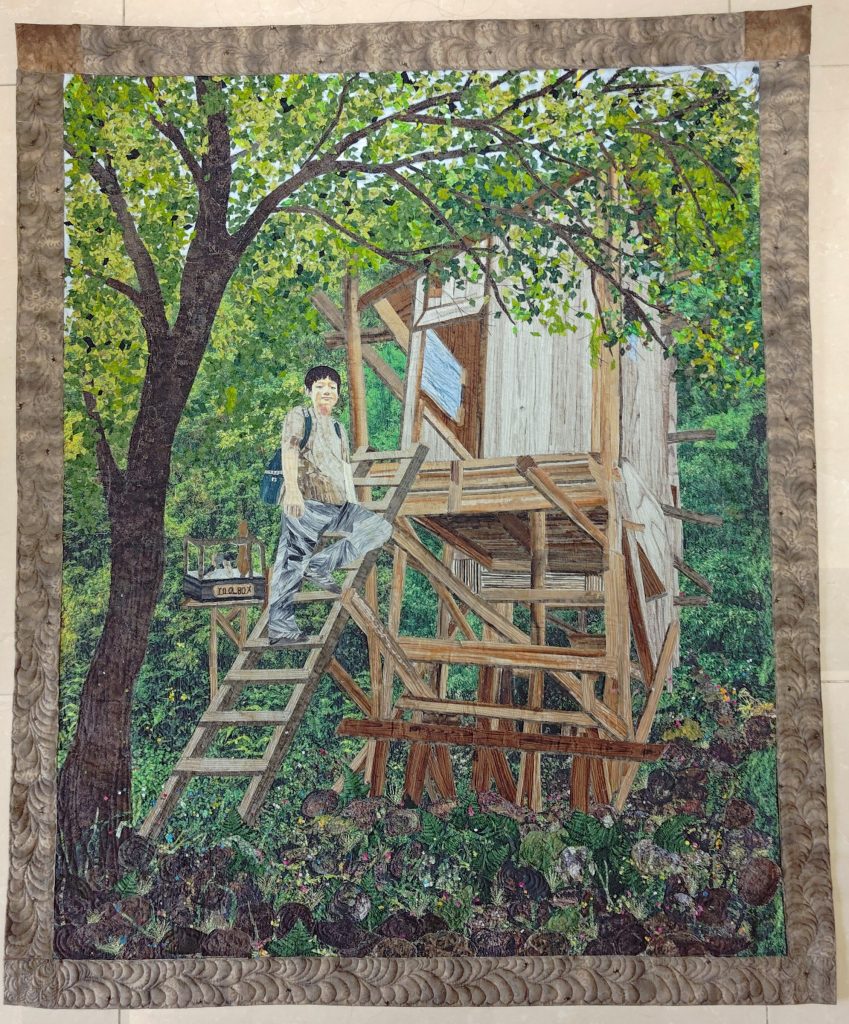
Witness the Growth of Life
by Ami Lee
New Taipei City, Taiwan
TAIWAN
Techniques: Hand pieced and quilted
Design Source: Original design
Meet Taylor, my grandson, a remarkable child. He enjoyed Lego in childhood and built wooden cabins as a teen. I quilted this fabric art to capture his journey. Let’s share and witness his growth.
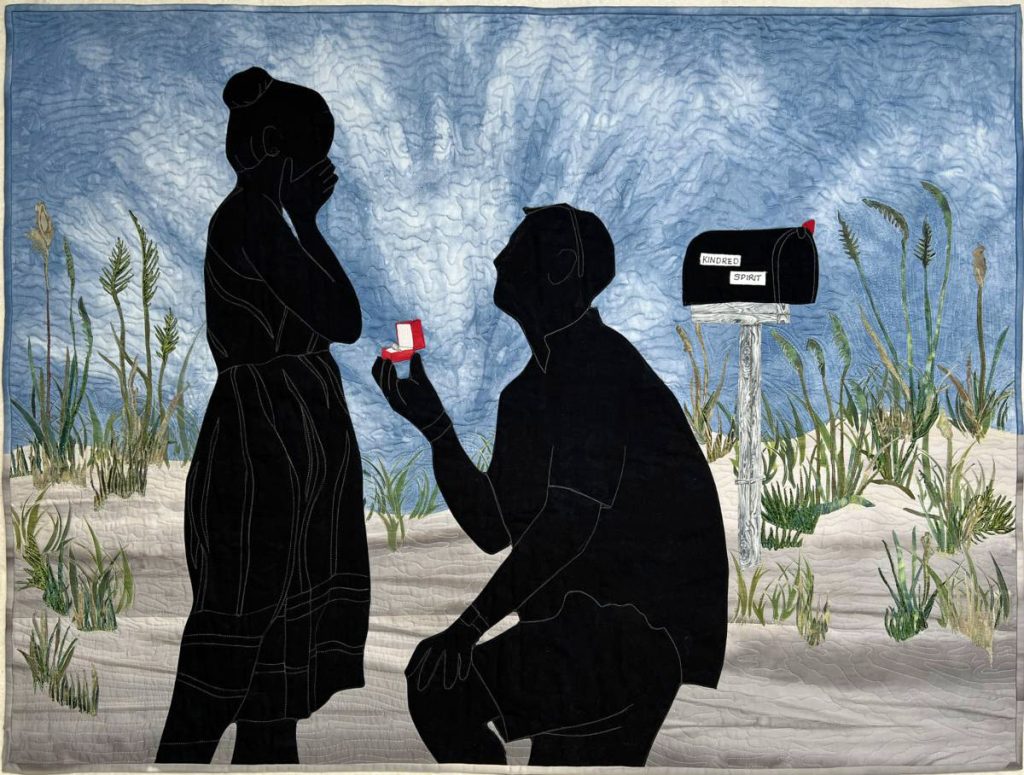
Yes
by Susan W Smith
Federal Way, WA
USA
Techniques: Hand dyed; machine appliquéd and quilted; photo transfer; trapunto; fused
Design Source: Original design
For three years, as my granddaughter and her boyfriend fell in love, they would walk to Kindred Spirit mailbox at the south end of Sunset Beach, North Carolina, leaving letters with dreams of love for the future. After asking her parents and showing them the ring, he took her for a walk to the mailbox and surprised her.


